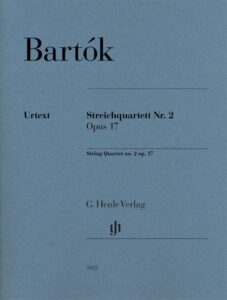Complex history
The 2nd String Quartet by Béla Bartók has been published in a new version, which is probably the version the composer intended.

Béla Bartók's eminently difficult string quartets have long since ceased to be the bugbears of a classical-romantic audience, but have become an integral part of the stage repertoire and a welcome challenge for professional string quartets. The protracted genesis and complex publishing history of the 2nd String Quartet op. 17, premiered on March 3, 1918 by the Waldbauer-Kerpely Quartet in Budapest, made the present new edition by G. Henle in collaboration with Editio Musica Budapest considerably more difficult.
The first motifs and drafts of individual passages were already written in 1914. Bartók continued to develop the piece in 1915 before taking a break and only entering the final phase of composition in the spring of 1917. The beginning and end of the process roughly coincide with the key dates of the First World War, the turmoil of which had a major influence on the composition. It was not Hungary's folklore that inspired him this time, but impressions from a trip to Algeria with his wife Márta before the war. Bartók put the famous collector-phonographer in front of "country dwellers" from various oases who had been taken by surprise. The results of the research trip, which was prematurely cut short due to unbearable heat and the composer's health problems, are reflected in the second movement, which is rhythmically and melodically Arabic in character. The resigned final movement, which his friend Zoltán Kodály gave the imaginary title "Sorrow", could be understood as a swan song to the sunken world of the Austro-Hungarian monarchy or even the European order by means of a senselessly murderous war with countless victims.
The increasing chaos during the last third of the war made communication between Bartók and Universal Edition in Vienna more difficult. Not all of the printed editions produced in the process of corrections survived. Even the composer himself was unable to clear up all discrepancies by the year of his death in 1945, which is why the new edition is based on the most likely final version according to Bartók's wishes. Nevertheless, some of the errors in the Universal, later Boosey & Hawkes edition have been eliminated, and performers can look forward to a revision that is convincing in all respects. Kodály's accessible notes on Bartók's work, which he had completely ignored in his publications for inexplicable reasons, are also exciting.
A great and extremely pleasant advance has been made with regard to the equalization of the music. For example, the part for the 1st violin has been extended from 11 pages to 17.
 Béla Bartók: String Quartet No. 2 op. 17, edited by László Somfai; Parts: HN 1422, € 24.00; study score: HN 7422, € 14.00; G. Henle, Munich
Béla Bartók: String Quartet No. 2 op. 17, edited by László Somfai; Parts: HN 1422, € 24.00; study score: HN 7422, € 14.00; G. Henle, Munich








